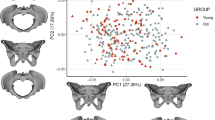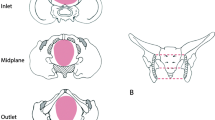Abstract
Neanderthal pelvic morphology is not well understood, despite the recent find and analysis of the Kebara 2 pelvis. Many of the proposed hypotheses focus on the possible need for a larger birth canal. A previously unexplored aspect involves possible direct obstetric implications of bone robusticity and density. These characteristics ocan affect obstetrics in modern humans, especially the molding of the neonate's head during parturition: engineering studies have shown that denser neonate cranial bones undergo less deformation, and thicker (more robust) cranial bones would also be expected to deform less during the birth process. These bone characteristics may also result in a less flexible birth canal. Thus, more robust or denser bones could result in the need for a larger birth canal or a smaller neonate head, due to decreased flexibility.
Examples from modern populations are discussed and the conclusions applied to Neanderthals, who are known to have had high bone robusticity and may have had high bone density, given their heavy musculature. (A positive association between muscle mass and bone density has been observed repeatedly in modern humans.) We conclude that bone robusticity and density may have obstetrical implications for Neanderthals, with particular importance for neonate head molding during birth.
Similar content being viewed by others
References
Alberman E., 1991. Are our babies becoming bigger?Journal of the Royal Society of Medicine 84: 257–260.
Anderson C.M., 1989. Neandertal pelves and gestation length: hypotheses and holism in paleoanthropology.American Anthropologist 91: 327–340.
Bar-Yosef O., Vandermeersch B., Arensburg B., Goldberg P., Laville H., Meignen L., Rak Y., Tchernof E., and Tillier A.-M., 1986. New data on the origin of modern man in the Levant.Current Anthropology, 27: 63–64.
Borell U. and Fernström I., 1957. The movements at the sacro-iliac joints and their importance to changes in the pelvic dimensions during parturition.Acta Obtetrica et Gynecologica Scandinavica 36: 42–57.
Caldwell W.E. and Moloy H.C., 1933. Anatomical variations in the female pelvis and their effect in labor, with a suggested classification.American Journal of Obstetrics & Gynecology 26: 479–505.
Cohn S.H., Abesamis C., Yasumura S., Aloia J.F., Zanzi I., and Ellis K.J., 1977. Comparative skeletal mass and radial bone mineral content in black and white women.Metabolism 26: 171–178.
Cunningham F.G., MacDonald P.C., and Gant N.F., 1989.Williams Obstetrics (18th ed). Norwalk, CT: Appleton & Lange.
Currey J.D., 1969. The mechanical consequences of variation in the mineral content of bone.Journal of Biomechanics 2: 1–11.
Dean M.C., Stringer C.B. and Bromages T.G., 1986. Age at death of the Neanderthal child from Devil's Tower, Gibraltar, and the implications for studies of general growth and development in Neanderthals.American Journal of Physical Anthropology 70: 301–309.
Ellis K.J. and Cohn S.H., 1975. Correlation between skeletal calcium mass and muscle mass in man.Journal of Applied Physiology 38: 455–460.
Frayer D.W., 1985. [Review of] The Shanidar Neandertals by Erik Trinkaus [=Trinkaus 1983].American Journal of Physical Anthropology 66: 339–340.
Garn S.M., Sanduski S.T., Nagy J.M. and McCann M.B., 1972. Advanced skeletal development in low-income Negro children.Journal of Pediatrics 80: 965–969.
Garrey M.M., Govan A.D.T., Hodge C. and Callander R., 1974.Obstetrics illustrated (2nd ed.): Edinburgh: Churchill Livingstone.
Greene D.L. and Sibley L., 1986. Neandertal public morphology and gestation length revisited.Current Anthropology 27: 517–518.
Hanna R.E. and Washburn S.L., 1953. The determination of the sex of skeletons, as illustrated by a study of the Eskimo pelvis.Human Biology 25: 21–27.
Heim J.-L., 1982.Les enfants néandertaliens de la Ferrassie: étude anthropologique et analyse ontogénique des hommes de Néandertal. Paris: Masson.
Heller C.A., Scott E.M., and Hammes L.M., 1967. Height, weight, and growth of Alaskan Eskimos.American Journal of Diseases of Children 113: 338–344.
Iscan M.Y. and Cotton T.S., 1985. The effect of age on the determination of race from the pelvis.Journal of Human Evolution 14: 275–282.
Jamison P.L., 1990. Secular trends and the pattern of growth in Arctic populations.Social Science & Medicine 30: 751–759.
Kriewal T.J. and G.K. McPherson, 1981. Effects of uterine contractility on the fetal cranim: perspectives from the past, present, and future. IN A. Milunsky, E.A. Friedman, & L. Gluck (eds.)Advances in perinatal medicine, volume 1. New York: Plenum Medical Book Company. Pp. 295–356.
Lande R., 1980. Sexual dimorphim, sexual selection, and adaptation in polygenics characters.Evolution 34: 292–305.
Leutenegger W., 1982. Encephalization and obstetrics in primates with particular reference to human evolution. IN E. Armstrong & D. Falk (eds.)Primate brain evolution: methods and concepts. New York: Plenum Press, Pp. 85–95.
Lovejoy C.O. and Trinkaus E., 1980. Strength and robusticity of the Neandertal tibia.American Journal of Physical Anthropology 53: 465–470.
Mather B.S., 1968. The effect of variation in specific gravity and ash content on the mechanical properties of human compact bone.Journal of Biomechanics 1: 207–210.
Mazess R.B. and Mather W.E., 1974. Bone mineral content of North Alaskan Eskimos.American Journal of Clinical Nutrition 27: 916–925.
Mazess R.B. and Mather W.E., 1975. Bone mineral content of North Alaskan Eskimos.Human Biology 47: 45–63.
Mazess R.B., 1966. Bone density in Sadlermiut Eskirno.Human Biology 38: 42–49.
Minugh-Purvis N., 1988.Patterns of craniofacial growth and development in Upper Pleistocene hominids. Ph.D. dissertation, Anthropology, University of Pennsylvania.
Moloy H.C., 1942. Studies on head molding during labor.American Journal of Obstetrics & Gynecology 44: 762–782.
Nelson D.A., Feingold M., Bolin F. and Parfitt A.M., 1991. Principal components analysis of regional bone density in black and white women: relationship to body size and composition.American Journal of Physical Anthropology 86: 507–514.
Ohlsén H., 1973. Moulding of the pelvis during labour.Acta Radiologica Diagnosis 14: 417–434.
Owen G. M. and Lubin A.H., 1973. Anthropometric differences between black and white preschool children.American Journal of Diseases of Children 126: 168–169.
Piantadosi S., Byar D.P. and Green S.B., 1988. The ecological fallacy.American Journal of Epidemiology 127: 893–904.
Pocock N.A., Eisman J.A., Hopper J.L., Yeates M.G., Sambrook P.N., and Eberl S., 1987. Genetic determinants of bone mass in adults.Journal of Clinical Investigation 80: 706–710.
Pollitzer W.S. and Anderson J.J.B., 1989. Ethnic and genetic differences in bone mass: a review with a hereditary vs environmental perspective.American Journal of Clinical Nutrition 50: 1244–1259.
Putschar W.G.J., 1976. The structure of the human symphysis pubis with special consideration of parturition and its sequelae.American Journal of Physical Anthropology 45: 589–594.
Rak Y. and Arensburg B., 1987. Kebara 2 Neanderthal pelvis: first look at a complete inlet.American Journal of Physical Anthropology 73: 227–231.
Reid I.R., Mackie M. and Ibbertson H.K., 1986. Bone mineral content in Polynesian and white New Zealand women.British Medical Journal. 292: 1547–1548.
Reid I.R., Cullen S., Schooler B.A., Livingstong N.E., and Evans M.C., 1990. Calcitropic hormone levels in Polynesians: evidence against their role in interracial differences in bone mass.Journal of Clinical Endocrinology and Metabolism 70: 1452–1456.
Rosenberg K. R., 1986.The functional significance of Neandertal public morphology. Ph.D. dissertation, Anthropology, University of Michigan.
Rosenberg K.R., 1988. The functional significance of Neandertal public length.Current Anthropology 29: 595–617.
Rosenberg K.R., 1992. The evolution of modern human childbirth.Yearbook of Physical Anthropology 35: 89–124.
Scheyer H.E., 1934. Anthropological and roentgenological observations on the pelves of Chinese Women.Chinese Medical Journal 48: 1228–1234.
Slemeda C.W., Christian J.C., Williams C.J., Norton J.A., and Johnston C.C. Jr., 1991. Genetic determinants of bone mass in adult women: a reevaluation of the twin model and the potential importance of gene interaction on heritability estimates.Journal of Bone & Mineral Research 6: 561–567.
Tague R.G., 1986.Obstetric adaptations of the human bony pelyis. Ph.D. dissertation, Biological Sciences, Kent State University.
Tague R.G., 1989. Variantion in pelvic size between males and females.American Journal of Physical Anthropology 80: 59–71.
Tague R.G., 1992. Sexual dimorphism in the human bony pelvis, with a consideration of the Neandertal pelvis from Kebara Cave, Israel.American Journal of Physical Anthropology 88: 1–21.
Thompson D.D. and Gunness-Hey M., 1981. Bone mineral-osteon analysis of Yupik-Inupiaq skeletons.American Journal of Physical Anthropology 55: 1–7.
Tompkins R.L. and Trinkaus E., 1987. La Ferrassie 6 and the development of Neandertal pubic morphology.American Journal of Physical Anthropology 73: 233–239.
Trevathan W.R., 1988a. Fetal emergence patterns in evolutionary perspective.American Anthropologist 90: 675–681.
Trevathan W.R., 1988b Comment [on Rosenberg 1988].Current Anthropology 29: 611.
Trinkaus E. and Tompkins R.L. 1990. The Neandertal life cycle: the possibility, probability, and preceptibility of contrasts with recent humans. In C. J. DeRousseau (ed.)Primate life history and evolution. New York Wiley-Liss, Pp. 153–180.
Trinkaus E., 1983a. Neandertal postcrania and adaptive shift to modern humans. In E. Trinkaus, (ed.),The Mousterian legacy: human biocultural change in the Upper Pleistocene. Oxford: B.A.R. Pp. 165–200.
Trinkaus E., 1983b.The Shanidar Neandertals. New York: Academic Press.
Trinkaus E., 1984. Neadertal pubic morphology and gestation length.Current Anthropology 25: 509–514.
Trotter M. and Hixon B.B., 1974. Sequential changes in weight, density, and percentage ash weight of human skeletons from an early fetal period through old age.The Anatomical Record 179: 1–18.
Trotter M., Broman G.E., and Peterson R.R., 1960. Densities of bones of white and negro skeletons.Journal of Bone and Joint Surgery 42-A: 50–58.
Turner W., 1886. The index of the pelvic brim as a basis of classification.Journal of Anatomy & Physiology 20: 125–143.
Virvidakis K., Georgiou E., Korkotsidis A., Ntalles K. and Proukakis C., 1990. Bone mineral content of junior competitive weightliters.International Journal of Sports Medicine 11: 244–246.
Walton S.M., 1981. Ethnic considerations in ultrasonic scanning of fetal biparietal diameers.The Australian & New Zealand Journal of Obstetrics & Gynaecology 21: 82–84.
Washburn S.L., 1948. Sex differences in the pubic bone.American Journal of Physical Anthopology 6: 199–207.
Washburn S.L., 1948. Sex differences in the pubic bone of Bantu and Bushman.American Journal of Physical Anthropology 7: 425–432.
Weiss G., O'Byrne E.M. and Steinetz B.G., 1976. Relaxin: a product of the human corpus luteum of pregnancy.Science 194: 948–949.
Wolpoff M.H., 1980.Paleoanthropology. New York: Alfred A. Kopf.
Author information
Authors and Affiliations
Rights and permissions
About this article
Cite this article
Friedlander, N.J., Jordan, D.K. Obstetric implications of neanderthal robusticity and bone density. Hum. Evol. 9, 331–342 (1994). https://doi.org/10.1007/BF02435519
Received:
Accepted:
Issue Date:
DOI: https://doi.org/10.1007/BF02435519




